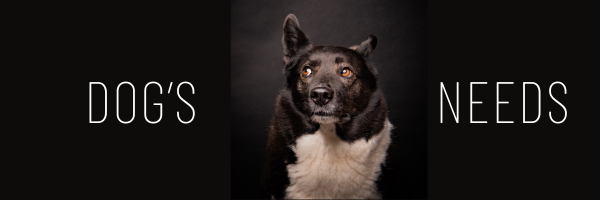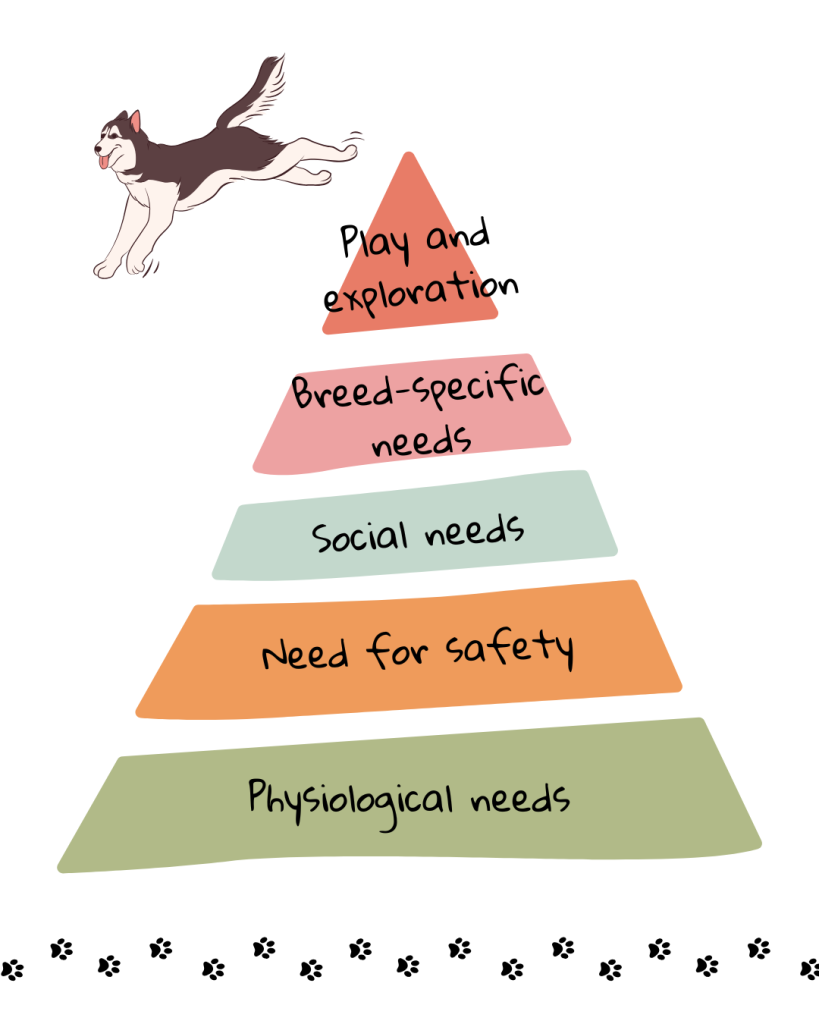
Do you know what your dog truly needs to feel safe? Every dog has their own needs – just as important as human needs. Often, as caregivers, we focus solely on feeding, walks, or playtime – forgetting that there’s much more behind these activities. Dogs, like humans, need security, stability, and relationships that give them a sense of trust and a calm life alongside people. Understanding a dog’s needs is the key to building a lasting and stable bond, one that is based not just on living under the same roof, but, above all, on genuine partnership. In this post, I will introduce you to the pyramid of a dog’s needs and show you how to use this knowledge to create a relationship with your dog that is full of harmony and mutual trust.
A dog is more than just a “pet”

Thousands of years ago, humans domesticated dogs, inviting them into their world. At first, dogs accompanied humans on hunts and protected people and their homes from dangers. Over time, they became not just helpers, but close life companions. However, domesticating a dog comes with great responsibility – if we brought them into our world, it is our duty to take care of them. Dogs are not just animals meant to be obedient and well-behaved. They are sentient beings with emotions, needs, and individual personalities. Just as humans do not live on food and sleep alone, dogs need more than a full bowl. They need security, stability, exploration, and socialization. Similar to human needs, which Maslow’s Hierarchy of Needs divides into basic survival needs and higher-order needs, a dog’s needs can also be categorized. They can be divided into inflexible needs (physiological needs, need for safety) and flexible needs (social needs, breed-specific needs, need for play and exploration). The graphic I created illustrates the pyramid of a dog’s needs, which I will now discuss step by step.
Physiological Needs
At the base of the dog’s needs pyramid are the most obvious needs: water, food, sleep, and health. This is the foundation without which a dog cannot function properly. A lack of proper nutrition or rest can affect not only a dog’s physical health but also their emotional well-being. Therefore, providing constant access to fresh water and ensuring a healthy, balanced, and appropriately tailored diet is the first step toward your dog’s happiness. Equally important are healthy sleep and a safe place to rest. It doesn’t matter whether this is a dog bed, a kennel, a human bed, or any other corner the dog chooses – what matters most is that the dog likes the place, feels safe there, can stretch out comfortably, and won’t be disturbed during rest. This topic could be expanded further to detail what constitutes a safe haven for a dog at home and how to ensure a healthy diet. That will come in future articles. Today, I want to focus on the essence of a dog’s needs and how meeting them can positively impact our relationship with our dog.
Need for Safety
The next pillar of a dog’s needs is the need for safety. Dogs require stability and predictability. A dog should know that their caregiver will return home, that the daily routine is relatively consistent, and that the environment they live in is friendly and calm. Chaos and shouting can cause stress and anxiety in a dog, making them fearful of their caregiver or prompting them to avoid them. For a dog, safety means trusting humans and being confident that their world is not a threat, but a place where they can live freely and without fear.
Social Needs
Once we have met a dog’s inflexible needs, we can focus on their flexible needs. Dogs are social animals – closeness and social bonds are as essential to them as family and friend connections are to humans. Spending time together, playing, training, engaging in physical activities with the dog, petting, or even just being present near them gives a dog a sense of belonging and acceptance. A lack of human attention, leaving a dog alone for long periods, or ignoring them can lead to feelings of loneliness, signs of canine depression, or behavioral problems. Meeting a dog’s social needs involves building an emotional human-dog relationship, but also ensuring contact with other dogs. However, it is important that these interactions are positive and help dogs feel better, rather than causing more fear or negative emotions. Caregivers often make the mistake of placing their dog in so-called “dog parks” where dogs roam freely without supervision. Such uncontrolled interactions often end up having negative consequences for our dog.
Breed-Specific Needs
The Dog Needs Pyramid I’ve presented applies to all dogs, but it’s important to note that each breed, and even each individual dog, may have slightly different requirements. If we choose a dog of a specific breed, we should also familiarize ourselves with its particular traits. Hunting dogs differ from herding dogs, and a French Bulldog has completely different needs than a Husky. Even in the case of so-called “mixed-breed” dogs, we can identify specific needs by observing their behavior and unique personality. Understanding a breed’s characteristics and adapting daily life to a dog’s natural predispositions allows us to meet their needs more consciously, and in turn, build a happier and calmer life together.
Play and Exploration
At the top of the pyramid, we find a dog’s needs for play and exploration. Dogs, both small and large, have a strong need to explore. That’s why walks only around the block or always on a leash are not enough. A walk on a leash is not the same as a walk off-leash, where a dog can set its own pace and choose its direction. Nowadays, there are many places where we can safely let our dog off-leash. However, if that’s not possible or if we worry about our dog’s safety, we can use long, several-meter-long lines that give the dog more freedom. This allows the dog to sniff around and explore the surroundings at their own pace. Play and exploration are not just forms of entertainment for dogs – they are also crucial for emotional and mental development. Sniffing, discovering new places, and exploring the environment help release tension and satisfy a dog’s natural curiosity about the world. Playing together, fetching, and scent-based exercises also strengthen the bond with the caregiver and make being together more enjoyable for the dog. As a sports psychologist, I recommend engaging with your dog in canine sports such as agility, flyball, dog frisbee, nosework, obedience (rally-O), canicross, bikejoring, dog sledding, or working trials. In addition to physical activity, these sports provide mental challenges, improve focus and self-control, and build a partnership-based relationship with humans.
We can see that the dog needs pyramid shows that a dog’s happiness starts with the basics: food, sleep, and safety, and develops through exploration, activity, and play. When we truly understand and meet these needs, our relationship with our dog becomes safe and full of trust.
If you feel it’s difficult to understand your dog’s needs, struggle to build a secure relationship, or, on the contrary, want to strengthen it and make it even deeper, it’s worth seeking support. As a psychologist, I work with caregivers and their dogs, helping them communicate better and create bonds based on trust. If you train your dog in sports and want not only to improve performance but also to enjoy your shared activities more, I invite you to get in touch. Together, we can make your relationship with your dog even fuller and more rewarding for both of you.
